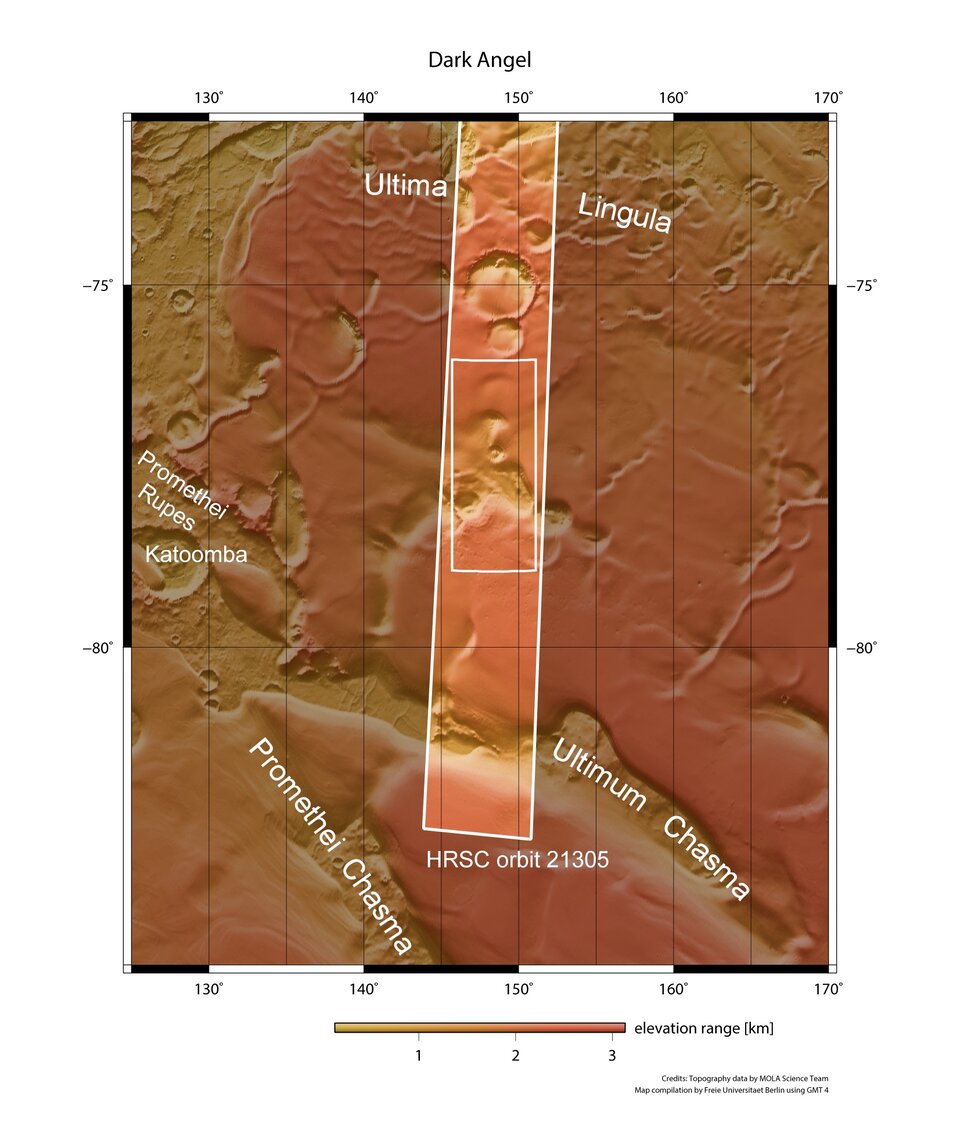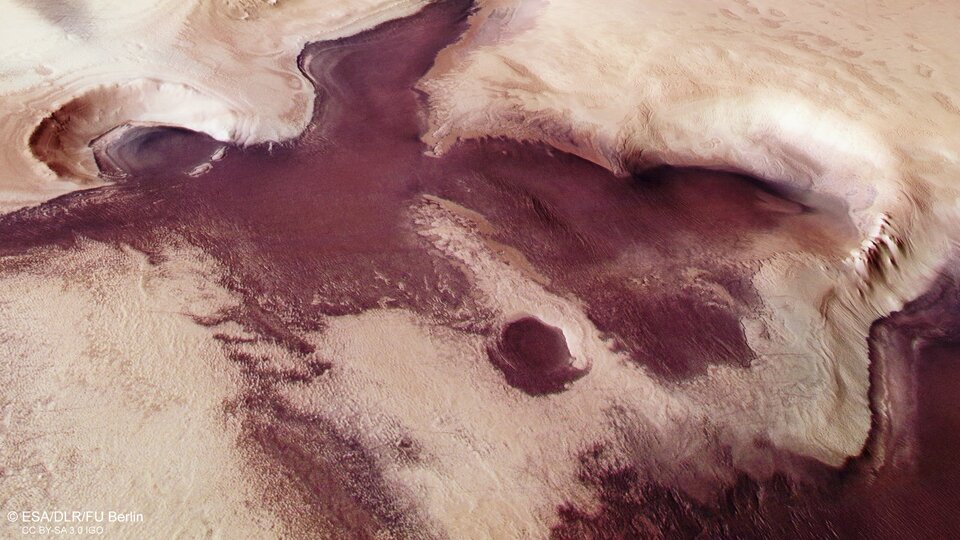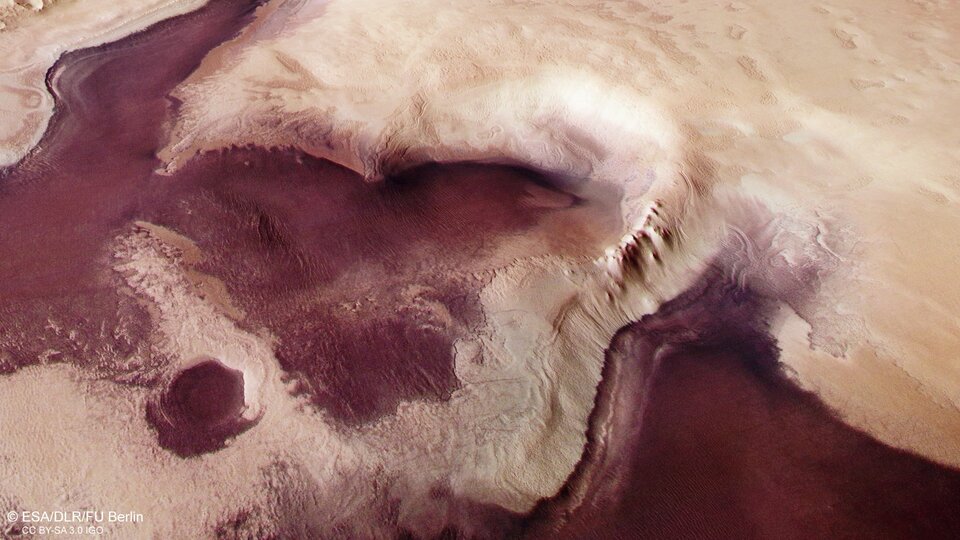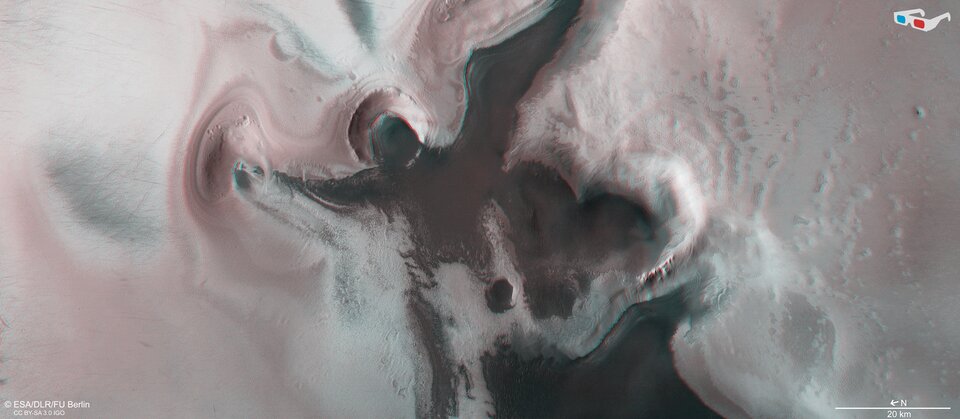19.12.2020

As the holiday season swiftly approaches, even our planetary neighbours are getting into the spirit – as shown by this perfect pair of festive silhouettes spotted by ESA’s Mars Express.
The defined wings of an angelic figure, complete with halo, can be seen sweeping up and off the top of the frame in this image from Mars Express’ High Resolution Stereo Camera, while a large heart sits just right of centre. These shapes appear to jump out of the light tan — or, in the spirit of the season, eggnog-coloured! — surface of Mars; their dark colour is a result of the composition of the constituent dune fields, which largely comprise sands rich in dark, rock-forming minerals that are also found on Earth (namely pyroxene and olivine).

This ethereal scene is found in the south polar region of Mars, with the pole itself located directly out of frame to the right (south). The south pole is typically covered in a 1.5 km-thick ice cap measuring around 400 km across and with a volume of 1.6 million cubic kilometres, just over 12% of which is water ice. The rest of the cap is largely composed of ‘dry ice’ (solid carbon dioxide), which freezes from the atmosphere during winter and then sublimates (turns from a solid to a gas) in the summer.
As Mars’ southern hemisphere is currently experiencing summer, this image shows the planet’s southern polar ice stores at their lowest annual levels.

The ‘angel’ and ‘heart’ are both composed of various interesting features. Firstly, the angel’s hand, seen as if reaching to the left, is thought to be a large sublimation pit, a type of feature that forms as ice turns to gas and leaves empty pockets and depressions in the planetary surface (a process that often occurs as the seasons change). Sublimation pits have been seen on other planets in the Solar System, such as Pluto, and can also be seen scattered across the terrain to the right.

Moving on to one of the angel’s most distinctive features, its halo, reveals yet more intriguing processes at play. The ‘head’ and halo are formed of an impact crater, created as a body from space flew inwards to collide with Mars’ crust. As this impactor hit it dug down into the surface, revealing the numerous layered deposits that make up the southern polar region. These subsurface layers can be glimpsed in other areas where the surface has been disturbed – areas that are clearly identifiable in the associated topographic view due to their notably low elevation – and hint at the long, complex, interesting history of this part of Mars.

Finally comes the heart, which is underscored by a steep escarpment – a line of cliffs or steep slopes created by erosive processes – and separated from the dark expanse of dunes below. The origin of this dark material, which is found all over Mars, remains unclear, but scientists posit that it once existed deeper below the surface in layers of material formed by ancient volcanic activity. Although this material was initially buried, it has since been brought to the surface by ongoing impacts and erosion, and then distributed more widely across the planet by martian winds.
This landscape also shows signs of dust devils in the dark, scratched, cross-hatched pattern to the left of the frame. Dust devils are common on Mars, and form as dust is whipped up from the Sun-warmed surface by wind. Here, dust devils have lifted surface material and carried it away, leaving dark marks in their wake.

The south pole of Mars is a fascinating region – and a watery one. Just a few months ago, Mars Express found signs of three new ponds of salty liquid water thought to be buried below the ice here, adding to the discovery of a large underground reservoir in 2018. Although the Red Planet appears dry and lifeless today, it was once far warmer and wetter, much like the early Earth. While the surface may no longer be hospitable to water, its subsurface may remain a friendly environment for ancient lake systems that, excitingly, may hold evidence of life on Mars.
As many gear up for a safe and restful Christmas period, Mars Express will not rest on its laurels; the spacecraft will continue to observe and image our planetary neighbour in detail, as it has done since it entered orbit around Mars in December 2003. The mission has revealed an astonishing amount about Mars in this time, helping us to better understand the planet’s water, geology, chemistry, atmosphere, moons, history, context in the Solar System, and much more.
Quelle: ESA
